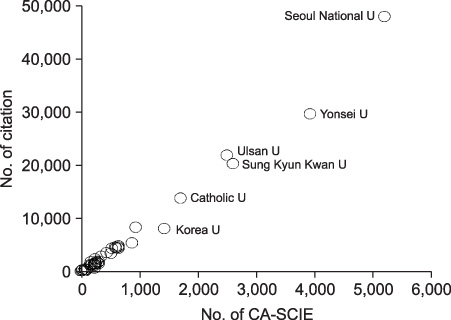J Korean Soc Med Inform.
2009 Sep;15(3):321-340.
Current Status of Scientific Citation Index Expanded Article Publications and Relationship with the Human Resources of Medical Schools in Korea
- Affiliations
-
- 1Department of Radiation Oncology, School of Medicine, Kyung Hee University, Korea. kangjino@paran.com
- 2Department of Medical Science, Graduate School of East West Medical Science, Kyung Hee University, Korea.
Abstract
OBJECTIVE
The purpose of this paper was to quantify both the output and the impact of the relationship between Korean medical schools and their human resource departments and their ability to support the basic data for research goals of Korean medical schools.
METHODS
The SCOPUS database was used to identify SCIE (scientific citation index expanded) articles produced by Korean medical schools between 1997 to 2008. The SCIE criteria, impact factors, and citation numbers were classified according to the database of Thomson Scientific Company. The human resources of medical schools were collected, such as the number of professors, graduate students, clinical fellows, residents, interns, and research assistants, through use of the medical deans' association biannual report.
RESULTS
There was a significant difference across Korean medical schools in the number of the SCIE articles and citation numbers, resulting in only a few institutions producing most of the impact. Among the variables, the proportion of professors of basic medical science (p<.01) and the number of research faculties per professor (p<.01), were related significantly to the SCIE per professor. The only factor affecting both SCIE number and SCIE per professor was the number of research faculties per professor. The number of graduate students in the medical school had no impact on productivity.
CONCLUSION
For the medical schools with restricted resources, the strategic plans for proper management of human resources are needed to promote scientific publication.
Figure
Reference
-
1. Analysis of NCI DB for SCI publications of Korea, 2007. MEST. 2008. Available at: http://www.mest.go.kr/me_kor/news/notice/broadcast/1240968_11163.html.2. Lim JK, Kim WK, Seong SY, Lee CS, Lim JH, Jeong JB, et al. Report of Korea Medical Research Status. 2006. Seoul: National Academy of Medicine of Korea;Available at: http://www.namok.or.kr.3. Erkut E. Measuring Canadian business school research output and impact. Can J Admin Sci. 2002. 19:97–123.
Article4. Garfield E, Melino G. The growth of the cell death field: an analysis from the ISI-Science citation index. Cell Death Differ. 1997. 4(5):352–361.
Article5. Foster WR. Impact factor as the best operational measure of medical journals. Lancet. 1995. 346(8985):1301.6. Hansson S. Impact factor as a misleading tool in evaluation of medical journals. Lancet. 1995. 346(8979):906.
Article7. Hirsch JE. An index to quantify an individual's scientific research output. Proc Natl Acad Sci U S A. 2005. 102(46):16569–16572.
Article8. Ivanova OA. The Hirsch index is a new criterion for evaluation of scientific activity. Biomed Khim. 2008. 54(1):5–11.
- Full Text Links
- Actions
-
Cited
- CITED
-
- Close
- Share
- Similar articles
-
- Current Status of SCI & SCIE Publications in the Field of Radiation Oncology in Korea
- Analysis of Scientific Papers Included in the Sciences Citation Index Expanded Written by South Korean Plastic Surgeons: 2001-2010
- Analysis of Scientific Publication Networks among Medical Schools in Korea
- How to successfully list a journal in the Social Science Citation Index or Science Citation Index Expanded
- Research in Korean Geriatric Psychiatry:Past, Present and Future




